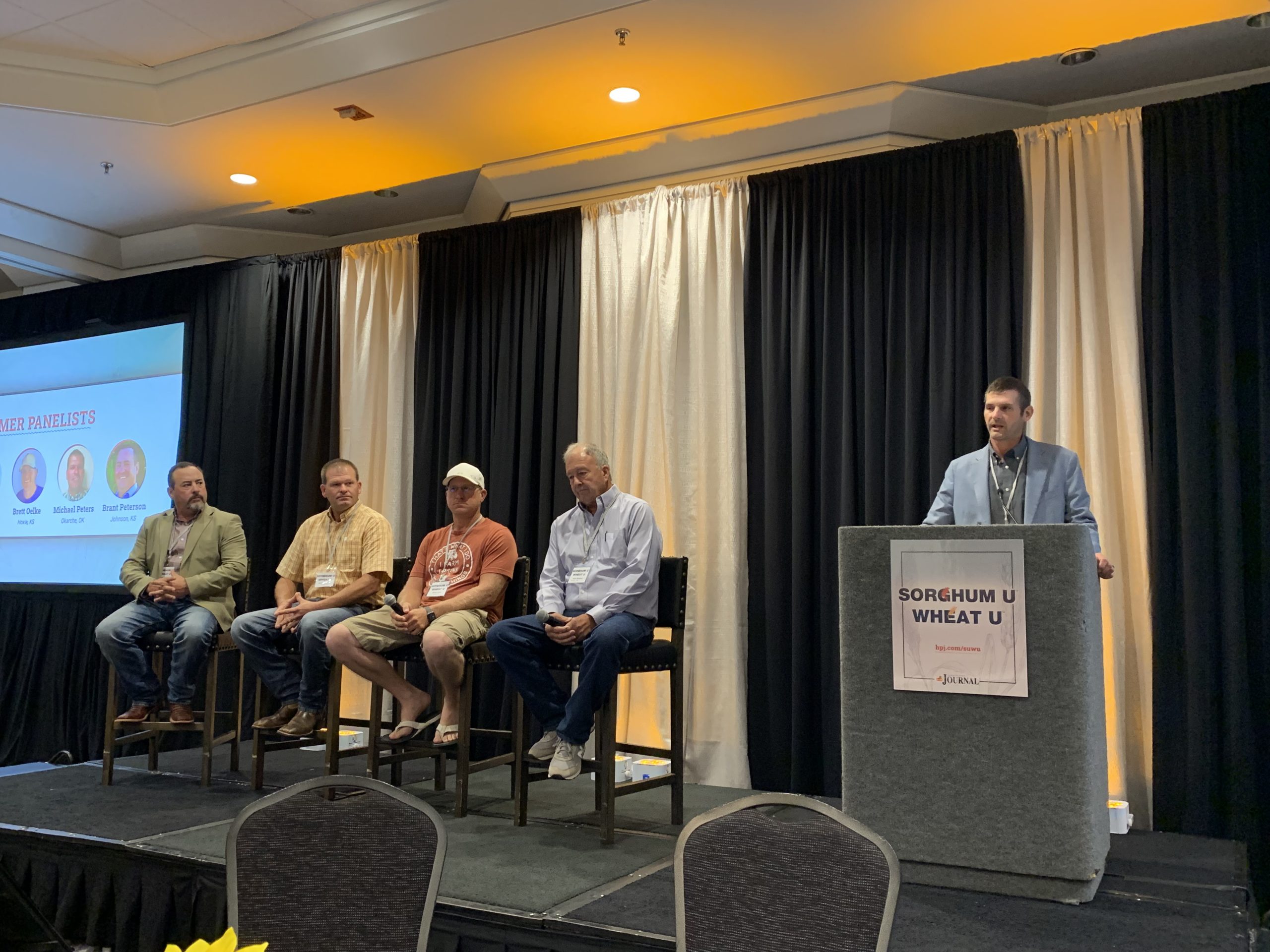Farmers discuss weeds, inputs and technology at Sorghum U Wheat U panel

Sorghum and wheat growers recently gathered in Wichita, Kansas, for Sorghum U Wheat U. Craig Meeker, chairman of the National Sorghum Producers and a Wellington, Kansas, farmer moderated the popular farmer panel discussion, which consisted of Kent Winter, Brett Oelke, Michael Peters and Brant Peterson. Since weeds were a major plague on farmers during this year’s wheat harvest, Meeker started off by asking the panelists what their most troublesome weed is and how they manage it.
Winter, a fifth-generation farmer from Andale, Kansas, and Oelke, a fifth-generation farmer from Sheridan County, Kansas, both named Palmer amaranth or pigweed as the weed they battle most often. Winter said he takes extreme measures to not let any pigweeds make seed during his wheat rotation by utilizing tillage.
“It’s just a constant battle,” Oelke explained. “The best thing we have found is to get a residual out there and never let the Palmer get up. We’re stacking three different residuals in our pre-plant burned down and coming back with two residuals that are post emerge.”
Peters, chairman of U.S. Wheat Associates and farmer from Okarche, Oklahoma, said in central Oklahoma where many growers practice wheat on wheat production, invasive rye grass is the bane of any wheat farmer.
“It will totally take your wheat crop over and it gets so thick when you’re trying to harvest the rye is still green, and it is terribly hard on your sickles,” he said. “Rye grass is resistant to about all of the chemicals out there. The only thing we have right now are some pre-emerge chemicals. It’s a timing issue as far as getting those chemicals down and maintaining control of that ryegrass, but if you can get that timing right, pre-emerge chemicals still work fairly well.”
Peters advised farmers who do not have a rye issue to make sure custom harvesters clean their equipment before entering new fields to prevent spreading the seed.
Peterson, a fifth-generation farmer from Stanton County, Kansas, was the perfect person to answer Meeker’s question about what farmers are doing or not doing that limits their yields. Peterson is the 2022 National Sorghum Producers Irrigated Sorghum Yield contest winner and the 2022 Sorghum Bin Busters award winner with a yield of 245.8 bushels per acre. His answer was simple, you’ve got to spend money to make money.
“You can be thrifty, but not be cheap,” Peterson said. “My grandfather told me that a lot of people think they’re saving money by not writing a check. I don’t believe that’s how you save. Don’t skimp on quality of seed, whether it’s wheat or sorghum. When it comes to fertilizer, put it on and don’t put it off.”
When the panelists were asked to name a piece of equipment or technology that has improved their operation the most, both Winter and Peters said grid soil testing has made a tremendous impact on their farming.
“Precision agriculture and being hooked up with a mechanism or a dealer that can take your grid soil sample results and go out there with a precision variable rate applied fertilizer across that field,” Winter said. “I was shocked by the amount of variability on some of my dark ground. I expected it in the sand along the river, but not on the dark ground. It needs to be looked at as a long-term expense that you’re amortizing over many years. This grid soil sampling is really a tool to help you make long term fertility decisions and make you good money.”
Peters said in his area of Oklahoma, pH levels can be an issue and soil testing can determine where the levels are low that need a lime application and it also saves money so farmers are not applying in areas where levels are adequate.
For both Oelke and Peterson, hydraulic downforce on planters and seeding equipment is an asset.
“We fight a lot of hard, dry soils when it gets hot and dry out in our area. We’ll start planting the 20th of April and into the 10th of June. When you get into that late May to June timeframe you can get a week of 100-degree, hot dry winds and then it’ll turn a beautiful seed bed into concrete. I’ve got a 24-row John Deere planter, and did I like writing a $35,000 check for it? No, but that goes back to saving yourself broke.”
Peterson also spoke to the usefulness of hydraulic downforce when it rains too much.
“This year we had 17 inches of rain in about nine weeks, and that’s more than we had the previous 30 months,” Peterson explained. “So the other side of hydraulic down-pressure is it backs off the pressure so we’re not compacting the sidewall.”
Lacey Vilhauer can be reached at 620-227-1871 or [email protected].


